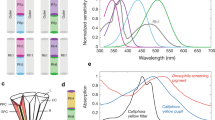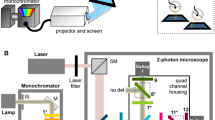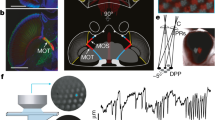Abstract
The brain's capacity to analyse and interpret information is limited ultimately by the input it receives. This sets a premium on information capacity of sensory receptors, which can be maximized by optimizing sensitivity, speed and reliability of response. Nowhere is selection pressure for information capacity stronger than in the visual system, where speed and sensitivity can mean the difference between life and death. Phototransduction in flies represents the fastest G-protein-signalling cascade known. Analysis in Drosophila has revealed many of the underlying molecular strategies, leading to the discovery and characterization of signalling molecules of widespread importance.
This is a preview of subscription content, access via your institution
Access options
Subscribe to this journal
Receive 51 print issues and online access
$199.00 per year
only $3.90 per issue
Buy this article
- Purchase on Springer Link
- Instant access to full article PDF
Prices may be subject to local taxes which are calculated during checkout




Similar content being viewed by others
References
Hille, B. G protein-coupled mechanisms and nervous signaling. Neuron 9, 187–195 (1992).
Hecht, S., Shlaer, S. & Pirenne, M. Energy quanta and vision. J. Gen. Physiol. 25, 819–840 (1942).
Yeandle, S. & Spiegler, J. B. Light-evoked and spontaneous discrete waves in the ventral nerve photoreceptor of Limulus. J. Gen. Physiol. 61, 552–571 (1973).
Baylor, D. A., Lamb, T. D. & Yau, K.-W. Responses of retinal rods to single photons. J. Physiol. 288, 613–634 (1979).
Aho, A. C., Donner, K., Hyden, C., Larsen, L. O. & Reuter, T. Low retinal noise in animals with low body-temperature allows high visual sensitivity. Nature 334, 348–350 (1988).
Wu, C.-F. & Pak, W. L. Light-induced voltage noise in the photoreceptor of Drosophila melanogaster. J. Gen. Physiol. 71, 249–268 (1978).
Howard, J., Blakeslee, B. & Laughlin, S. B. The intracellular pupil mechanism and the maintenance of photoreceptor signal:noise ratios in the blowfly Lucilia cuprina. Proc. R. Soc. Lond. B 231, 415–435 (1987).
Juusola, M. & Hardie, R. C. Light Adaptation in Drosophila photoreceptors. I. Response dynamics and signaling efficiency at 25 °C. J. Gen. Physiol. 117, 3–25 (2001).
Lamb, T. D. Gain and kinetics of activation in the G-protein cascade of phototransduction. Proc. Natl Acad. Sci. USA 93, 566–570 (1996).
Koutalos, Y. & Yau, K. W. Regulation of sensitivity in vertebrate rod photoreceptors by calcium. Trends Neurosci. 19, 73–81 (1996).
Hochstrate, P. & Hamdorf, H. Microvillar components of light adaptation in blowflies. J. Gen. Physiol. 95, 891–910 (1990).
Henderson, S. R., Reuss, H. & Hardie, R. C. Single photon responses in Drosophila photoreceptors and their regulation by Ca2+. J. Physiol. 524, 179–194 (2000).
Vogt, K. & Kirschfeld, K. The chemical identity of the chromophores of fly visual pigment. Naturwissenschaften 71, 211–213 (1984).
Hardie, R. C. The photoreceptor array of the dipteran retina. Trends Neurosci. 9, 419–423 (1986).
Bloomquist, B. T. et al. Isolation of putative phospholipase C gene of Drosophila, norpA and its role in phototransduction. Cell 54, 723–733 (1988).
Scott, K., Becker, A., Sun, Y., Hardy, R. & Zuker, C. Gqα protein function in vivo: genetic dissection of its role in photoreceptor cell physiology. Neuron 15, 919–927 (1995).
Niemeyer, B. A., Suzuki, E., Scott, K., Jalink, K. & Zuker, C. S. The Drosophila light-activated conductance is composed of the two channels TRP and TRPL. Cell 85, 651–659 (1996).
Putney, J. W. & McKay, R. R. Capacitative calcium entry channels. BioEssays 21, 38–46 (1999).
Nasi, E., del Pilar Gomez, M. & Payne, R. in Handbook of Biological Physics (eds Stavenga, D. G., de Grip, W. J. & Pugh, E. N.) 389–448 (Elsevier, 2000).
Acharya, J. K., Jalink, K., Hardy, R. W., Hartenstein, V. & Zuker, C. S. InsP3 receptor is essential for growth and differentiation but not for vision in Drosophila. Neuron 18, 881–887 (1997).
Raghu, P. et al. Normal phototransduction in Drosophila photoreceptors lacking an InsP3 receptor gene. Mol. Cell. Neurosci. 15, 429–445 (2000).
Smith, D. P. et al. Photoreceptor deactivation and retinal degeneration mediated by a photoreceptor-specific protein-kinase-C. Science 254, 1478–1484 (1991).
Hardie, R. C. et al. Protein kinase C is required for light adaptation in Drosophila photoreceptors. Nature 363, 634–637 (1993).
Chyb, S., Raghu, P. & Hardie, R. C. Polyunsaturated fatty acids activate the Drosophila light-sensitive channels TRP and TRPL. Nature 397, 255–259 (1999).
Estacion, M., Sinkins, W. G. & Schilling, W. P. Regulation of Drosophila transient receptor potential-like (TrpL) channels by phospholipase C-dependent mechanisms. J. Physiol. 530, 1–19 (2001).
Masai, I., Okazaki, A., Hosoya, T. & Hotta, Y. Drosophila retinal degeneration A gene encodes an eye-specific diacylglycerol kinase with cysteine-rich zinc-finger motifs and ankyrin repeats. Proc. Natl Acad. Sci. USA 90, 11157–11161 (1993).
Raghu, P. et al. Constitutive activity of the light-sensitive channels TRP and TRPL in the Drosophila diacylglycerol kinase mutant, rdgA. Neuron 26, 169–179 (2000).
Huang, C. L., Feng, S. Y. & Hilgemann, D. W. Direct activation of inward rectifier potassium channels by PIP2 and its stabilization by Gβγ. Nature 391, 803–806 (1998).
Chuang, H. H. et al. Bradykinin and nerve growth factor release the capsaicin receptor from PtdIns(4,5)P2-mediated inhibition. Nature 411, 957–962 (2001).
Hardie, R. C. et al. Calcium influx via TRP channels is required to maintain PIP2 levels in Drosophila photoreceptors. Neuron 30, 149–159 (2001).
Li, C. J. et al. INAF, a protein required for transient receptor potential Ca2+ channel function. Proc. Natl Acad. Sci. USA 96, 13474–13479 (1999).
Ferreira, P. A. & Pak, W. L. Bovine phospholipase C highly homologous to the norpA protein of Drosophila is expressed specifically in cones. J. Biol. Chem. 269, 3129–3131 (1994).
Womack, K. B. et al. Do phosphatidylinositides modulate vertebrate phototransduction? J. Neurosci. 20, 2792–2799 (2000).
Scott, K. & Zuker, C. Lights out: deactivation of the phototransduction cascade. Trends Biochem. Sci. 22, 350–354 (1997).
Chen, J., Makino, C. L., Peachey, N. S., Baylor, D. A. & Simon, M. I. Mechanisms of rhodopsin inactivation in vivo as revealed by a COOH-terminal truncation mutant. Science 267, 374–377 (1995).
Mendez, A. et al. Rapid and reproducible deactivation of rhodopsin requires multiple phosphorylation sites. Neuron 28, 153–164 (2000).
Vinos, J., Jalink, K., Hardy, R. W., Britt, S. G. & Zuker, C. S. A G protein-coupled receptor phosphatase required for rhodopsin function. Science 277, 687–690 (1997).
Byk, T., BarYaacov, M., Doza, Y. N., Minke, B. & Selinger, Z. Regulatory arrestin cycle secures the fidelity and maintenance of the fly photoreceptor cell. Proc. Natl Acad. Sci. USA 90, 1907–1911 (1993).
Dolph, P. J. et al. Arrestin function in inactivation of G protein-coupled receptor rhodopsin in vivo. Science 260, 1910–1916 (1993).
Cook, B. et al. Phospholipase C and termination of G-protein-mediated signalling in vivo. Nature Cell Biol. 2, 296–301 (2000).
He, W., Cowan, C. W. & Wensel, T. G. RGS9, a GTPase accelerator for phototransduction. Neuron 20, 95–102 (1998).
Fesenko, E. E., Kolesnikov, S. S. & Lyubarsky, A. L. Induction by cyclic GMP of cationic conductance in plasma membrane of retinal rod outer segment. Nature 313, 310–313 (1985).
Kaupp, U. B. & Koch, K. W. Role of cGMP and Ca2+ in vertebrate photoreceptor excitation and adaptation. Annu. Rev. Physiol. 54, 153–175 (1992).
Hsu, Y. T. & Molday, R. S. Modulation of the cGMP-gated channel of rod photoreceptor cells by calmodulin. Nature 361, 76–79 (1993).
Gray, P. & Attwell, D. Kinetics of light-sensitive channels in vertebrate photoreceptors. Proc. R. Soc. Lond. B 223, 379–388 (1985).
Kaupp, U. B. Family of cyclic nucleotide gated ion channels. Curr. Opin. Neurobiol. 5, 434–442 (1995).
Montell, C. & Rubin, G. M. Molecular characterization of Drosophila trp locus, a putative integral membrane protein required for phototransduction. Neuron 2, 1313–1323 (1989).
Hardie, R. C. & Minke, B. The trp gene is essential for a light-activated Ca2+ channel in Drosophila photoreceptors. Neuron 8, 643–651 (1992).
Reuss, H., Mojet, M. H., Chyb, S. & Hardie, R. C. In vivo analysis of the Drosophila light-sensitive channels, TRP and TRPL. Neuron 19, 1249–1259 (1997).
Phillips, A. M., Bull, A. & Kelly, L. E. Identification of a Drosophila gene encoding a calmodulin-binding protein with homology to the trp phototransduction gene. Neuron 8, 631–642 (1992).
Xu, X. Z. S., Chien, F., Butler, A., Salkoff, L. & Montell, C. TRPγ, a Drosophila TRP-related subunit, forms a regulated cation channel with TRPL. Neuron 26, 647–657 (2000).
Harteneck, C., Plant, T. D. & Schultz, G. From worm to man: three subfamilies of TRP channels. Trends Neurosci. 23, 159–166 (2000).
Clapham, D. E., Runnels, L. W. & Strubing, C. The trp ion channel family. Nature Rev. Neurosci. 2, 387–396 (2001).
Hardie, R. C. & Minke, B. Phosphoinositide-mediated phototransduction in Drosophila photoreceptors: the role of Ca2+ and trp. Cell Calcium 18, 256–274 (1995).
Scott, K., Sun, Y. M., Beckingham, K. & Zuker, C. S. Calmodulin regulation of Drosophila light-activated channels and receptor function mediates termination of the light response in vivo. Cell 91, 375–383 (1997).
Hardie, R. C. & Mojet, M. H. Magnesium-dependent block of the light-activated and trp-dependent conductance in Drosophila photoreceptors. J. Neurophysiol. 74, 2590–2599 (1995).
Leskov, I. B. et al. The gain of rod phototransduction: reconciliation of biochemical and electrophysiological measurements. Neuron 27, 525–537 (2000).
Calvert, P. D. et al. Membrane protein diffusion sets the speed of rod phototransduction. Nature 411, 90–94 (2001).
Neubig, R. Membrane organization in G-protein mechanisms. FASEB J. 8, 939–946 (1994).
Sheng, M. & Sala, C. PDZ domains and the organization of supramolecular complexes. Annu. Rev. Neurosci. 24, 1–29 (2001).
Tsunoda, S. et al. A multivalent PDZ-domain protein assembles signalling complexes in a G-protein-coupled cascade. Nature 388, 243–249 (1997).
Montell, C. TRP trapped in fly signaling web. Curr. Opin. Neurobiol. 8, 389–397 (1998).
Huber, A. et al. The transient receptor potential protein (Trp), a putative store-operated Ca2+ channel essential for phosphoinositide-mediated photoreception, forms a signaling complex with NorpA, InaC and InaD. EMBO J. 15, 7036–7045 (1996).
Li, H. S. & Montell, C. TRP and the PDZ protein, INAD, form the core complex required for retention of the signalplex in Drosophila photoreceptor cells. J. Cell Biol. 150, 1411–1422 (2000).
Tsunoda, S., Sun, Y., Suzuki, E. & Zuker, C. Independent anchoring and assembly mechanisms of INAD signaling complexes in Drosophila photoreceptors. J. Neurosci. 21, 150–158 (2001).
Xu, X. Z. S., Choudhury, A., Li, X. L. & Montell, C. Coordination of an array of signaling proteins through homo- and heteromeric interactions between PDZ domains and target proteins. J. Cell Biol. 142, 545–555 (1998).
Montell, C. Visual transduction in Drosophila. Annu. Rev. Cell Dev. Biol. 15, 231–268 (1999).
vanHuizen, R. et al. Two distantly positioned PDZ domains mediate multivalent INAD-phospholipase C interactions essential for G protein-coupled signaling. EMBO J. 17, 2285–2297 (1998).
Huber, A., Sander, P., Bahner, M. & Paulsen, R. The TRP Ca2+ channel assembled in a signaling complex by the PDZ domain protein INAD is phosphorylated through the interaction with protein kinase C (ePKC). FEBS Lett. 425, 317–322 (1998).
Liu, M. Y., Parker, L. L., Wadzinski, B. E. & Shieh, B. H. Reversible phosphorylation of the signal transduction complex in Drosophila photoreceptors. J. Biol. Chem. 275, 12194–12199 (2000).
He, W. et al. Modules in the photoreceptor RGS9-1/Gβ5L GTPase-accelerating protein complex control effector coupling, GTPase acceleration, protein folding, and stability. J. Biol. Chem. 275, 37093–37100 (2000).
Schwarzer, A., Schauf, H. & Bauer, P. J. Binding of the cGMP-gated channel to the Na/Ca-K exchanger in rod photoreceptors. J. Biol. Chem. 275, 13448–13454 (2000).
Korschen, H. G. et al. Interaction of glutamic-acid-rich proteins with the cGMP signalling pathway in rod photoreceptors. Nature 400, 761–766 (1999).
Lamb, T. D. Gain and kinetics of activation in the G-protein cascade of phototransduction. Proc. Natl Acad. Sci. USA 93, 566–570 (1996).
Minke, B. & Hardie, R. C. in Handbook of Biological Physics (eds Stavenga, D. G., de Grip, W. J. & Pugh, E. N.) 449–525 (Elsevier, 2000).
Pak, W. L., Ostroy, S. E., Deland, M. C. & Wu, C.-F. Photoreceptor mutant of Drosophila: is protein involved in intermediate steps of phototransduction? Science 194, 956–959 (1976).
Scott, K. & Zuker, C. S. Assembly of the Drosophila phototransduction cascade into a signalling complex shapes elementary responses. Nature 395, 805–808 (1998).
Bahner, M., Sander, P., Paulsen, R. & Huber, A. The visual G protein of fly photoreceptors interacts with the PDZ domain assembled INAD signaling complex via direct binding of activated Gαq to phospholipase Cβ. J. Biol. Chem. 275, 2901–2904 (2000).
Tsunoda, S. & Zuker, C. S. The organization of INAD-signaling complexes by a multivalent PDZ domain protein in Drosophila photoreceptor cells ensures sensitivity and speed of signaling. Cell Calcium 26, 165–171 (1999).
Oberwinkler, J. & Stavenga, D. G. Calcium transients in the rhabdomeres of dark- and light-adapted fly photoreceptor cells. J. Neurosci. 20, 1701–1709 (2000).
Wong, F. Adapting bump model for ventral photoreceptors of Limulus. J. Gen. Physiol. 79, 1089–1114 (1982).
Kirschfeld, K. & Vogt, K. Calcium ions and pigment migration in fly photoreceptors. Naturwissenschaften 67, 516–517 (1980).
Stavenga, D. G. Insect retinal pigments: spectral characteristics and physiological functions. Prog. Retinal Eye Res. 15, 231–259 (1996).
Lamb, T. D. & Pugh En Jr A quantitative account of the activation steps involved in phototransduction in amphibian photoreceptors. J. Physiol. 449, 719–758 (1992).
Miklos, G. L. G. & Rubin, G. M. The role of the genome project in determining gene function: insights from model organisms. Cell 86, 521–529 (1996).
Hardie, R. C. Whole-cell recordings of the light-induced current in Drosophila photoreceptors: evidence for feedback by calcium permeating the light sensitive channels. Proc. R. Soc. Lond. B 245, 203–210 (1991).
Ranganathan, R., Harris, G. L., Stevens, C. F. & Zuker, C. S. A Drosophila mutant defective in extracellular calcium-dependent photoreceptor deactivation and rapid desensitization. Nature 354, 230–232 (1991).
Whitlock, G. G. & Lamb, T. D. Variability in the time course of single photon responses from toad rods: termination of rhodopsin's activity. Neuron 23, 337–351 (1999).
Shieh, B. H. & Zhu, M. Y. Regulation of the TRP Ca2+ channel by INAD in Drosophila photoreceptors. Neuron 16, 991–998 (1996).
Chevesich, J., Kreuz, A. J. & Montell, C. Requirement for the PDZ domain protein, INAD, for localization of the TRP store-operated channel to a signaling complex. Neuron 18, 95–105 (1997).
Laughlin, S. B., van Steveninck, R. R. D. & Anderson, J. C. The metabolic cost of neural information. Nature Neurosci. 1, 36–41 (1998).
Warr, C. G. & Kelly, L. E. Identification and characterization of two distinct calmodulin-binding sites in the Trpl ion-channel protein of Drosophila melanogaster. Biochem. J. 314, 497–503 (1996).
Zhang, Z. et al. Activation of Trp3 by inositol 1,4,5-trisphosphate receptors through displacement of inhibitory calmodulin from a common binding domain. Proc. Natl Acad. Sci. USA 98, 3168–3173 (2001).
Niemeyer, B. A., Bergs, C., Wissenbach, U., Flockerzi, V. & Trost, C. Competitive regulation of CaT-like-mediated Ca2+ entry by protein kinase C and calmodulin. Proc. Natl Acad. Sci. USA 98, 3600–3605 (2001).
Fleig, A. et al. Calcium-entry second messenger function for ADP-ribose via gating of the LTRPC2 cation channel. Biophys. J. 80, 2749 (2001).
Runnels, L. W., Yue, L. X. & Capham, D. E. TRP-PLIK, a bifunctional protein with kinase and ion channel activities. Science 291, 1043–1047 (2001).
Acknowledgements
We thank R. Paulsen, T. D. Lamb and R. Ranganathan for constructive comments on the manuscript. Apologies to colleagues whose work we failed to cite owing to space limitations.
Author information
Authors and Affiliations
Corresponding author
Rights and permissions
About this article
Cite this article
Hardie, R., Raghu, P. Visual transduction in Drosophila. Nature 413, 186–193 (2001). https://doi.org/10.1038/35093002
Issue Date:
DOI: https://doi.org/10.1038/35093002
This article is cited by
-
In vivo identification of Drosophila rhodopsin interaction partners by biotin proximity labeling
Scientific Reports (2024)
-
Nematostella vectensis exemplifies the exceptional expansion and diversity of opsins in the eyeless Hexacorallia
EvoDevo (2023)
-
OSM-9 and OCR-2 TRPV channels are accessorial warm receptors in Caenorhabditis elegans temperature acclimatisation
Scientific Reports (2020)
-
Evolutionary constraints on flicker fusion frequency in Lepidoptera
Journal of Comparative Physiology A (2020)
-
Suppression of Gq and PLC gene expression has a small effect on quantum bumps in vivo in Periplaneta americana
Journal of Comparative Physiology A (2020)
Comments
By submitting a comment you agree to abide by our Terms and Community Guidelines. If you find something abusive or that does not comply with our terms or guidelines please flag it as inappropriate.



